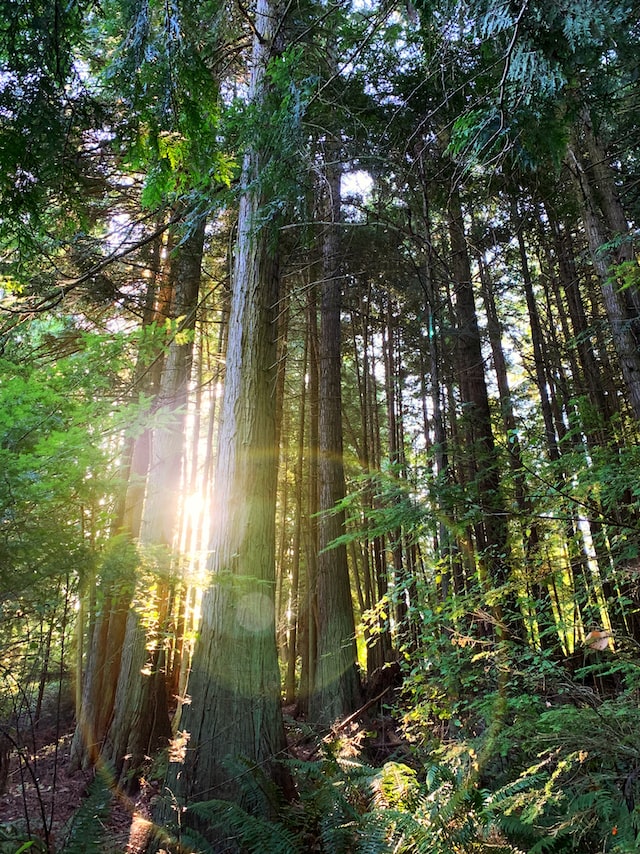Embrace Confidence with Cedar Cologne
Cedar: Aromatic Majesty in Many Realms - From Perfumes to Fun Crazy Facts
Cedar, with its majestic and captivating aroma, holds a prominent place in numerous domains, including perfumes, fragrance, therapeutic oils, food, medicinal systems, history, and even fun crazy facts. This article explores the multifaceted nature of cedar, uncovering its diverse applications and intriguing aspects that have fascinated people throughout history.
1. Cedar in Perfumes and Fragrance
Cedar's rich, woody scent has made it a prized ingredient in the world of perfumery and fragrance. The oil extracted from various cedar species, such as Atlas cedar (Cedrus atlantica) and Virginia cedar (Juniperus virginiana), has a distinct and invigorating aroma. Perfumers often use cedarwood oil as a base note in their creations, providing depth, warmth, and longevity to the fragrance. Cedar's earthy charm blends harmoniously with a wide range of scents, making it a favorite choice in both masculine and feminine perfumes.
2. Cedar in Therapeutic Oils
Cedarwood essential oil is celebrated for its therapeutic properties. With its grounding and calming effects, it is commonly used in aromatherapy to promote relaxation and reduce stress and anxiety. The oil's antifungal and antimicrobial attributes also make it beneficial for skin conditions like acne and eczema. When diffused, cedarwood oil fills the air with its soothing aroma, creating a serene and tranquil ambiance.
3. Cedar in Culinary Delights
While not commonly used as a primary ingredient in culinary dishes, cedarwood planks are a popular choice for grilling and smoking food. Cedar planks infuse a delightful, smoky aroma into meats and fish, enhancing their flavors. Additionally, cedar leaves and twigs have been utilized in traditional cuisines for imparting a unique fragrance to certain dishes.
4. Cedar in Medicinal Systems
Cedar has a long history of use in traditional medicine, particularly in herbal remedies and natural healing practices. Native American tribes and other indigenous cultures used cedar leaves, bark, and wood in medicinal preparations to treat various ailments. Cedar was valued for its potential to alleviate respiratory issues, purify the air, and soothe skin irritations.
5. Historical Significance of Cedar
Cedar's significance stretches back to ancient times, where it held symbolic and religious importance in several cultures. In ancient Egypt, cedarwood was used in the embalming process and as an offering to the gods. The ancient Sumerians, Babylonians, and Greeks also valued cedar for its association with deities and its role in various rituals.
6. Fun and Crazy Facts about Cedar
a. Cedar's Resilience: Cedarwood is known for its durability and resistance to decay. It is often used for constructing furniture, houses, and even boats due to its strength and longevity.
b. Cedar's Insect-Repellent Properties: Cedarwood is a natural insect repellent, which is why cedar chests and closets are popular for protecting clothing from moths and other pests.
c. Cedar in Ancient Texts: Cedar is mentioned multiple times in religious texts such as the Bible and the Quran, symbolizing strength, protection, and spirituality.
d. Cedar's Association with Healing: Cedar was believed to possess healing properties, and cedarwood oil was used in ancient cultures for purifying and cleansing purposes.
e. Cedar in Traditional Tribes: Indigenous tribes often used cedarwood for crafting totem poles, ceremonial objects, and as a part of their spiritual rituals.
Cedar, with its alluring aroma and versatile applications, has become a symbol of strength, resilience, and spirituality. Its presence in perfumes, therapeutic oils, food, medicinal systems, and historical contexts highlights its timeless appeal and cultural significance. Whether it is gracing the air with its aromatic majesty in perfumes or providing a sense of calm and tranquility in therapeutic oils, cedar continues to captivate and inspire. As we reflect on cedar's profound role throughout history and its intriguing qualities, it stands as a testament to nature's gifts and humanity's enduring fascination with the power of scent and symbolism.
Cedar, with its majestic and captivating aroma, holds a prominent place in numerous domains, including perfumes, fragrance, therapeutic oils, food, medicinal systems, history, and even fun crazy facts. This article explores the multifaceted nature of cedar, uncovering its diverse applications and intriguing aspects that have fascinated people throughout history.
1. Cedar in Perfumes and Fragrance
Cedar's rich, woody scent has made it a prized ingredient in the world of perfumery and fragrance. The oil extracted from various cedar species, such as Atlas cedar (Cedrus atlantica) and Virginia cedar (Juniperus virginiana), has a distinct and invigorating aroma. Perfumers often use cedarwood oil as a base note in their creations, providing depth, warmth, and longevity to the fragrance. Cedar's earthy charm blends harmoniously with a wide range of scents, making it a favorite choice in both masculine and feminine perfumes.
2. Cedar in Therapeutic Oils
Cedarwood essential oil is celebrated for its therapeutic properties. With its grounding and calming effects, it is commonly used in aromatherapy to promote relaxation and reduce stress and anxiety. The oil's antifungal and antimicrobial attributes also make it beneficial for skin conditions like acne and eczema. When diffused, cedarwood oil fills the air with its soothing aroma, creating a serene and tranquil ambiance.
3. Cedar in Culinary Delights
While not commonly used as a primary ingredient in culinary dishes, cedarwood planks are a popular choice for grilling and smoking food. Cedar planks infuse a delightful, smoky aroma into meats and fish, enhancing their flavors. Additionally, cedar leaves and twigs have been utilized in traditional cuisines for imparting a unique fragrance to certain dishes.
4. Cedar in Medicinal Systems
Cedar has a long history of use in traditional medicine, particularly in herbal remedies and natural healing practices. Native American tribes and other indigenous cultures used cedar leaves, bark, and wood in medicinal preparations to treat various ailments. Cedar was valued for its potential to alleviate respiratory issues, purify the air, and soothe skin irritations.
5. Historical Significance of Cedar
Cedar's significance stretches back to ancient times, where it held symbolic and religious importance in several cultures. In ancient Egypt, cedarwood was used in the embalming process and as an offering to the gods. The ancient Sumerians, Babylonians, and Greeks also valued cedar for its association with deities and its role in various rituals.
6. Fun and Crazy Facts about Cedar
a. Cedar's Resilience: Cedarwood is known for its durability and resistance to decay. It is often used for constructing furniture, houses, and even boats due to its strength and longevity.
b. Cedar's Insect-Repellent Properties: Cedarwood is a natural insect repellent, which is why cedar chests and closets are popular for protecting clothing from moths and other pests.
c. Cedar in Ancient Texts: Cedar is mentioned multiple times in religious texts such as the Bible and the Quran, symbolizing strength, protection, and spirituality.
d. Cedar's Association with Healing: Cedar was believed to possess healing properties, and cedarwood oil was used in ancient cultures for purifying and cleansing purposes.
e. Cedar in Traditional Tribes: Indigenous tribes often used cedarwood for crafting totem poles, ceremonial objects, and as a part of their spiritual rituals.
Cedar, with its alluring aroma and versatile applications, has become a symbol of strength, resilience, and spirituality. Its presence in perfumes, therapeutic oils, food, medicinal systems, and historical contexts highlights its timeless appeal and cultural significance. Whether it is gracing the air with its aromatic majesty in perfumes or providing a sense of calm and tranquility in therapeutic oils, cedar continues to captivate and inspire. As we reflect on cedar's profound role throughout history and its intriguing qualities, it stands as a testament to nature's gifts and humanity's enduring fascination with the power of scent and symbolism.
To experience augmented reality, please open the Facebook-app using QR code and point to the image below
Cedar is a type of tree that belongs to the pine family (Pinaceae). It is known for its durable wood and aromatic scent. There are several different species of cedar, including the Eastern Red Cedar (Juniperus virginiana) and the Western Red Cedar (Thuja plicata). Cedar is commonly used for outdoor construction and furniture, as well as for cedar chests and closets to repel moths and other insects. Some species of cedar trees are also grown for ornamental purposes in gardens and landscaping.
Bold and Commanding Woody Scent
Cedar trees have a long history of cultural and practical significance. They have been used by many different cultures throughout history for a variety of purposes.
The ancient Egyptians used cedar wood for building ships and for constructing the interiors of tombs. The wood was also used to make furniture and other household items.
The ancient Babylonians and Assyrians used cedar for construction of temples and palaces, and for making door frames, beams, and other architectural elements.
Cedar wood was also highly valued by the ancient Greeks and Romans, who used it for shipbuilding and for constructing public buildings.
In the indigenous cultures of North America, cedar wood was used for making canoes, totem poles, and other objects. The Western Red Cedar was also used for making clothing and for spiritual rituals.
In more recent history, cedar has been used for making a variety of products such as pencils, fence posts, shingles, and siding. Its natural resistance to rot, decay and insects made it an ideal material for outdoor uses.
Overall, Cedar has been used for centuries due to its durability, strength, and resistance to decay. Cedar's pleasant aroma and natural resistance to insects also made it a popular choice for many different uses.
The ancient Egyptians used cedar wood for building ships and for constructing the interiors of tombs. The wood was also used to make furniture and other household items.
The ancient Babylonians and Assyrians used cedar for construction of temples and palaces, and for making door frames, beams, and other architectural elements.
Cedar wood was also highly valued by the ancient Greeks and Romans, who used it for shipbuilding and for constructing public buildings.
In the indigenous cultures of North America, cedar wood was used for making canoes, totem poles, and other objects. The Western Red Cedar was also used for making clothing and for spiritual rituals.
In more recent history, cedar has been used for making a variety of products such as pencils, fence posts, shingles, and siding. Its natural resistance to rot, decay and insects made it an ideal material for outdoor uses.
Overall, Cedar has been used for centuries due to its durability, strength, and resistance to decay. Cedar's pleasant aroma and natural resistance to insects also made it a popular choice for many different uses.
Discover the Essence of Masculinity
Cedar trees have been associated with various myths and legends throughout history. Here are a few examples:
In many cultures cedar was also associated with protection, purification and longevity. The wood was often used to make amulets and charms to keep away evil spirits and bad luck.
Overall, cedar has held a special place in many cultures and its wood has been used for both practical and spiritual purposes.
- In ancient Egypt, cedar was considered to be a symbol of eternal life and was often used in the construction of tombs and sarcophagi.
- In ancient Babylon and Assyria, cedar was considered to be a sacred tree and was associated with the god Marduk. It was believed that the aroma of cedar wood had the power to ward off evil spirits.
- In Greek mythology, cedar was associated with the god Apollo and was said to have been used to make the lyre, a musical instrument that was played by the god.
- In Norse mythology, cedar was associated with the god Thor and was believed to have been used to make his hammer
- In North America, the Western Red Cedar was considered a sacred tree by many indigenous cultures. It was used in spiritual rituals and ceremonies, and its wood was used to make objects that were believed to have spiritual power.
In many cultures cedar was also associated with protection, purification and longevity. The wood was often used to make amulets and charms to keep away evil spirits and bad luck.
Overall, cedar has held a special place in many cultures and its wood has been used for both practical and spiritual purposes.
Embody Confidence with Our Cedarwood Scent
Cedar essential oil, which is derived from the wood and needles of cedar trees, is believed to have a variety of medicinal properties. Some of the most commonly cited benefits of cedar essential oil include:
Additionally, as with any essential oil, cedar oil should be used with care, as it is highly concentrated, and can be toxic if ingested, inhaled or applied undiluted to the skin. It's always recommended to use essential oils in dilution with a carrier oil, and use them under the guidance of a qualified aromatherapist or healthcare professional.
- Antiseptic properties: Cedar essential oil is believed to have antiseptic properties that can help to prevent the growth of bacteria, viruses, and other microorganisms. This can make it useful for treating a variety of skin conditions, such as acne, eczema, and psoriasis.
- Anti-inflammatory properties: Cedar essential oil is believed to have anti-inflammatory properties that can help to reduce inflammation and swelling in the body. This can make it useful for treating conditions such as arthritis, rheumatism, and gout.
- Expectorant properties: Cedar essential oil is believed to have expectorant properties that can help to break up mucus and relieve congestion. This can make it useful for treating conditions such as colds, flu, and bronchitis.
- Sedative properties: Cedar essential oil is believed to have sedative properties that can help to calm the mind and promote relaxation. This can make it useful for treating conditions such as anxiety, insomnia, and stress.
Additionally, as with any essential oil, cedar oil should be used with care, as it is highly concentrated, and can be toxic if ingested, inhaled or applied undiluted to the skin. It's always recommended to use essential oils in dilution with a carrier oil, and use them under the guidance of a qualified aromatherapist or healthcare professional.
Crafting the Perfect Men's Fragrance
Cedarwood essential oil has a warm, woody, and slightly sweet aroma that has made it a popular ingredient in perfumes and fragrances. The oil is extracted from the wood of different species of cedar trees, including the Eastern Red Cedar (Juniperus virginiana) and the Western Red Cedar (Thuja plicata).
Cedarwood oil has a fixative property which means it can help to prolong the longevity of a fragrance. Due to its natural woody, warm and slightly sweet scent, it is often used as a base note in perfumes, colognes and other scented products. It blends well with other woody oils such as sandalwood, vetiver, and patchouli, as well as with floral and citrus oils.
Cedarwood oil is also believed to have properties such as grounding, calming and balancing, which made it a popular choice for perfumes and colognes meant to have a relaxing and soothing effect.
Cedarwood oil is also used in perfumes, soaps, lotions, and other personal care products, due to its natural antiseptic and insect-repelling properties, and its ability to improve the health and appearance of the skin.
Overall, cedarwood essential oil is a popular ingredient in perfumes and fragrances due to its warm, woody aroma and its ability to act as a fixative to prolong the longevity of a fragrance. It is also used in personal care products and also as a natural remedy.
Cedarwood oil has a fixative property which means it can help to prolong the longevity of a fragrance. Due to its natural woody, warm and slightly sweet scent, it is often used as a base note in perfumes, colognes and other scented products. It blends well with other woody oils such as sandalwood, vetiver, and patchouli, as well as with floral and citrus oils.
Cedarwood oil is also believed to have properties such as grounding, calming and balancing, which made it a popular choice for perfumes and colognes meant to have a relaxing and soothing effect.
Cedarwood oil is also used in perfumes, soaps, lotions, and other personal care products, due to its natural antiseptic and insect-repelling properties, and its ability to improve the health and appearance of the skin.
Overall, cedarwood essential oil is a popular ingredient in perfumes and fragrances due to its warm, woody aroma and its ability to act as a fixative to prolong the longevity of a fragrance. It is also used in personal care products and also as a natural remedy.
Experience the Power of Cedarwood
There are many perfumes that feature cedarwood as an ingredient. Here are a few examples of well-known perfumes that feature cedarwood as an important note:
- Tom Ford's "Cedarwood Atlas" - This cologne features cedarwood as the main note, blended with other woody and spicy notes such as patchouli and black pepper.
- Le Labo's "Cedarwood Atlas" - This cedarwood fragrance is blended with other woody and spicy notes such as patchouli, Virginia cedarwood, and black pepper.
- Jo Malone's "Cedarwood & Juniper" - This cologne features cedarwood and juniper as the main notes, blended with other woody and herbal notes such as rosemary and pine.
- Byredo's "Cedar Rose" - This perfume features a combination of cedarwood and rose as the main notes, blended with other floral and woody notes such as patchouli and musk.
- Dior's "Sauvage" - This cologne features cedarwood as one of the main notes, blended with other woody and spicy notes such as bergamot, Sichuan pepper and ambroxan.
- Serge Lutens' "Cedar Wood & Mousse de Saxe" - This perfume features cedarwood as the main note, blended with other woody and mossy notes such as moss and vetiver.
Join Scentopia, Sentosa's latest tourist attraction wonderful orchid scent crafting, fragrance tour, bridal shower or corporate team building which includes perfume making onsite and offsite, beach activities and more. We also serve primary school learning journey, secondary students and pupil on industrial excursions. Know more about our orchids perfume bar or therapeutic orchid scents and other wellness aromas. Conatct Perfume workshop or book a scent crafting session here.







